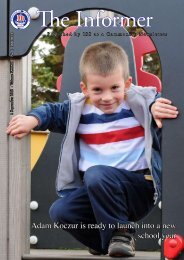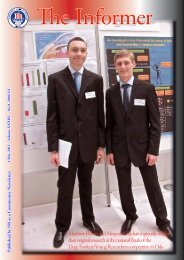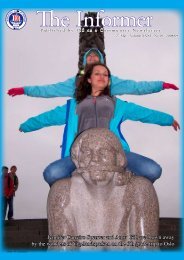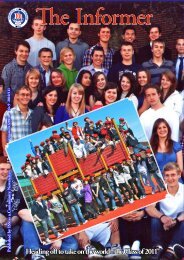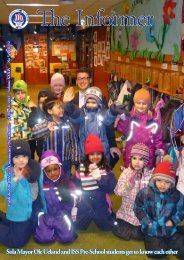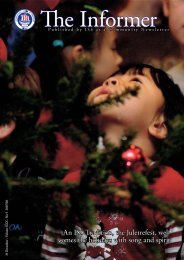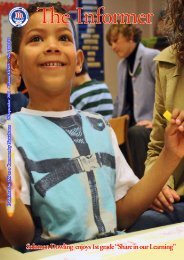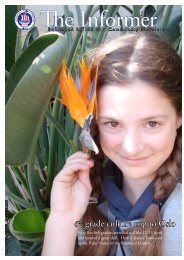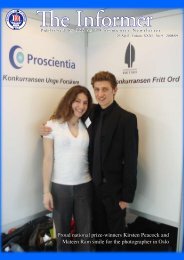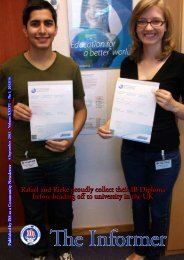March 2013 - the International School of Stavanger
March 2013 - the International School of Stavanger
March 2013 - the International School of Stavanger
You also want an ePaper? Increase the reach of your titles
YUMPU automatically turns print PDFs into web optimized ePapers that Google loves.
All <strong>School</strong> News<strong>International</strong> <strong>School</strong> <strong>of</strong> <strong>Stavanger</strong>Admissions: Morning Connections Series<strong>March</strong> & April <strong>2013</strong>Hello,You are invited to join us for <strong>the</strong> next "Morning Connections" events! These seminars are intended to provide parents withopportunities to meet o<strong>the</strong>rs in <strong>the</strong> ISS community and discuss a range <strong>of</strong> topics relevant to expat life, education and/or livingin Norway. More details and quick sign-up links below. Hope to see you <strong>the</strong>re!Kindly,Katharine MudraAdmissions & Communications Officeradmissions@isstavanger.noMORNING CONNECTIONS:Thursdays, <strong>March</strong> 21 & April 25 -- 8:45-10:30 -- ISSTwo upcoming “Morning Connections” topics are:<strong>March</strong> 21: Culture Shock and Creating ConnectionsMany <strong>of</strong> ISS’ globetrotting families have lived in numerous corners around <strong>the</strong> world, sometimes quickly saying goodbye to onehome and culture and onto <strong>the</strong> next within months. The international way <strong>of</strong> living brings many benefits, but <strong>the</strong>re are certainlychallenges too. It’s been said that “a successful moveable family is one in which each family member feels welcome, safe andvalued not only as a member <strong>of</strong> his/her family but also in <strong>the</strong> new community in which <strong>the</strong>y live.” This session looks at cultureshock for parents and managing change as adults. It will also overview strategies for dealing with culture shock, such ascreating new support networks and meaningful connections during time <strong>of</strong> change.We’re fortunate to have <strong>the</strong> talents and expertise <strong>of</strong> an ISS parent, Dr. Vlatka Duric, to lead <strong>the</strong> session. Dr. Duric is apsychologist from Australia with extensive clinical and research experience with individuals and groups addressing change;adjustment to change and loss; and, how to create safety and stability during and after change. She has developed and ledmany workshops and seminars in a variety <strong>of</strong> settings such as communication skills training for medical students as well asexperienced doctors and nurses. She is a mo<strong>the</strong>r <strong>of</strong> two ISS students, an expatriate, a trailing spouse and once a selfproclaimedTCK (‘third culture kid’) herself.RSVP via http://isstavanger.wufoo.com/forms/x7x0r3/.April 25: Brain Research and Learning“The brain is <strong>the</strong> last and grandest biological frontier, <strong>the</strong> most complex thing we have yet discovered in our universe. Itcontains hundreds <strong>of</strong> billions <strong>of</strong> cells interlinked through trillions <strong>of</strong> connections. The brain boggles <strong>the</strong> mind.” – James Watson,winner <strong>of</strong> <strong>the</strong> 1962 Nobel prize in Physiology/Medicine.Parents, teachers, school administrators, psychologists and neuroscientists from around <strong>the</strong> world have been studying <strong>the</strong> field<strong>of</strong> neuroeducation for decades. And <strong>the</strong> latest research about <strong>the</strong> adolescent brain, character development and intellectualdevelopment is proving quite intriguing.How do our perceptions <strong>of</strong> brain development and age differ from what <strong>the</strong> research is telling us? What are <strong>the</strong> environmental,home and school patterns that lead to healthy – or unhealthy – development <strong>of</strong> children? How do we adjust to <strong>the</strong> complexbrain and motivational patterns represented by <strong>the</strong> diverse students in today’s classroom?After introducing <strong>the</strong> brain and its inner workings, Ms. Carol Wallace, middle school principal, will discuss: <strong>the</strong> differencebetween <strong>the</strong> young adolescent and adolescent brain (when is a brain fully developed?), <strong>the</strong> difference between <strong>the</strong> boy and girlbrain (what mindsets and motivation strategies work well for each gender?), and <strong>the</strong> effect <strong>of</strong> sleep, nutrition and technologyon brain development and a child’s attitude and ability to learn. Carol will share school practices and tips for home that areaimed at creating positive experiences beneficial to character and cognitive development.RSVP via http://isstavanger.wufoo.com/forms/k7p9k5/.28 · The Informer 6 <strong>March</strong> <strong>2013</strong> www.isstavanger.no




